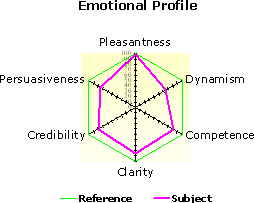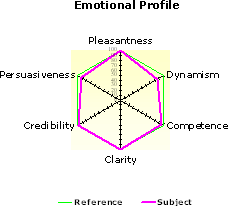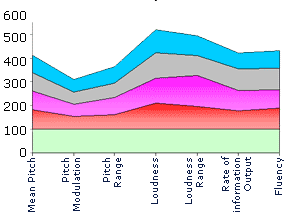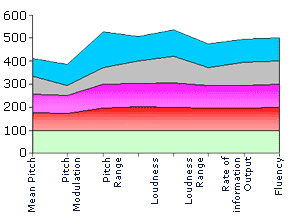 |
 |
 |
|
|
Voice Analysis and Coaching
The human voice can be a powerful tool for persuasion,
motivation and leadership. Yet all too often, people come over
instead as bland, lifeless and uninspiring. The voice
speaks, the crowd sleeps! The voice encodes the speaker’s
personality, yet precisely measuring and analysing the way
an individual uses his voice is a difficult task and has in
the past been entirely subjective.
Working with a linguistics expert at the University of
Geneva, we have turned this subjective approach into a
wholly objective one. Thanks to unique computer software, we
are able to analyse a client’s voice and detect with
precision its emotional profile. We then work with that
client to improve their voice, making them sound, for
example, much more persuasive, credible or competent.
How we do this
First we record voice samples on digital tape. These are
analysed and the results are compared with a ‘reference’
speaker’s voice. The ‘reference’ values were compiled by
analysing several hundred highly effective communicators.
The resulting data give us the key areas for coaching.
Then, we coach. Coaching does not follow a standard
formula, but instead a number of specifically tailored
strategies can be set. |
|
 |
Case Study
An individual before and after voice coaching.
Procedure: We recorded and analysed the voice of a
male client. This was repeated 3 months later, after 3
two-hour sessions of coaching.
| General data |
Average Values |
Reference |
| |
Before |
After |
|
| Mean pitch (Hz) |
81.70 |
81.26 |
90-120 |
| Mean loudness (dB) |
67.96 |
65.96 |
60-65 |
| Information output rate
(syllables/sec) |
3.63 |
4.3 |
4.5-5.5 |
|
Before |
After (3 months later) |
 |
 |
| The speaker's voice is
very low in pitch (which is excellent!), it is
weakly modulated, and has a good loudness level. The
rate of information output is a little low which is
mainly due to numerous disfluencies (e.g. "you
know") which were not included in the calculation of
the rate of information output. |
The pitch of the
speaker's voice is still excellent (i.e. very low),
his voice is still rather weakly modulated, but all
of the other vocal parameters show excellent values.
Compared with the previous analysis fluency is
perfect. |
 |
 |
Speaker's Image
The speaker's strongest point is the pleasantness of
his voice which is due to low pitch and excellent
voice quality. The least good trait of the speaker's
image is lack of dynamism. The latter then affects
nearly all the other components of the image, in
particular the person's image of competence and his
persuasiveness. The speaker may also appear as
lacking personal involvement in the topic. |
Speaker's Image
Globally, the speaker's image is almost perfect. It
still lacks some dynamism, which is due to weak
pitch modulation. As both pitch range and rate of
delivery have greatly improved, the total
persuasiveness is good. |
Voice Parameters
 |
Voice Parameters
 |
Objectives of
training in vocal delivery skills:
- To increase emotional involvement through
increase in melodic emphasis
- To decrease disfluencies
|
Objectives of
training in delivery skills:
- To increase melodic emphasis (only if the
speaker is prepared to let his emotions be
heard!)
|
Observations on the coaching effect
- This person was already a decent presenter.
- His limiting factor was his voice, especially
disfluencies and lack of emotional involvement.
- The training of his voice involved 3 two-hour
individual sessions at his offices.
- The second recording shows clear improvements in
voice profile in the key areas of pitch and fluency,
almost to ‘ideal’ standard (in line with the reference).
- The speaker’s image has improved across all
parameters, without the loss of the excellent initial
score on pleasantness.
- The coaching required is highly bespoke, and will
only be effective if the result - as in this case - is a
voice which is still natural yet much more effective.
Frequently asked questions
| Q |
|
Who was involved in setting the
reference? |
| A |
|
Several hundred highly respected
orators and presenters. We choose the most
appropriate reference model from an extensive
database covering many professions. We were once
asked to measure the vocal characteristics of the
best broker in a brokerage company. |
 |
| Q |
|
Is it possible to score >100%? |
| A |
|
Yes, as 100% is set by the
reference voices. 100% is ‘ideal’ though, for
example, it is possible to be too loud. There is no
universally ideal voice for all situations. We have
different references for different situations. A
doctor’s voice speaking to a patient must be
different from a salesperson’s voice speaking to a
customer. |
 |
| Q |
|
Does your approach differ for
presenting and dialogue? |
| A |
|
Yes. We measure whether the person
has a collaborative or hostile vocal style in
dialogue or negotiation. We measure the degree of
speech accommodation (who adapts to whom) - the
concept is well known in scientific circles. Larry
King’s TV interviews were analysed for the degree of
accommodation. The result was that he accommodated
to people he considered of higher social status than
himself and he did not accommodate to those of lower
social class. |
 |
| Q |
|
How long do the benefits last? |
| A |
|
It depends on how keen the person
is to keep the newly acquired skill alive i.e. to
use it in other than business situations. It is
likely that permanent improvement needs several
sessions with practice in between. The techniques
are so powerful that one ‘round’ can produce
permanent improvements. |
 |
| Q |
|
Who does the analysis? |
| A |
|
The analysis is done by an expert
in vocal signal analysis who has been involved in
university research for the past 20 years. She has a
doctorate in psychology, and has specialised in the
psycho-linguistic aspects of communication since
1998. Her research is continuously updated for the
latest scientific discoveries in the field of vocal
rhetoric and speaking styles, and she is a regular
speaker on the conference circuit. |
 |
| Q |
|
How much coaching is required
before we see and improvement? |
| A |
|
It largely depends on what needs to
be improved, by how much and how quickly the
individual responds to the coaching. Typically
between 2 and 4 1-1 sessions. |
| |
| Q |
|
Is there a particular trend in
the way that businesses managers speak? |
| A |
|
Here in London many speakers do not
modulate their voices enough, so they sound bored
and therefore less effective. |
|
|



![]() Artography Web Design
Artography Web Design